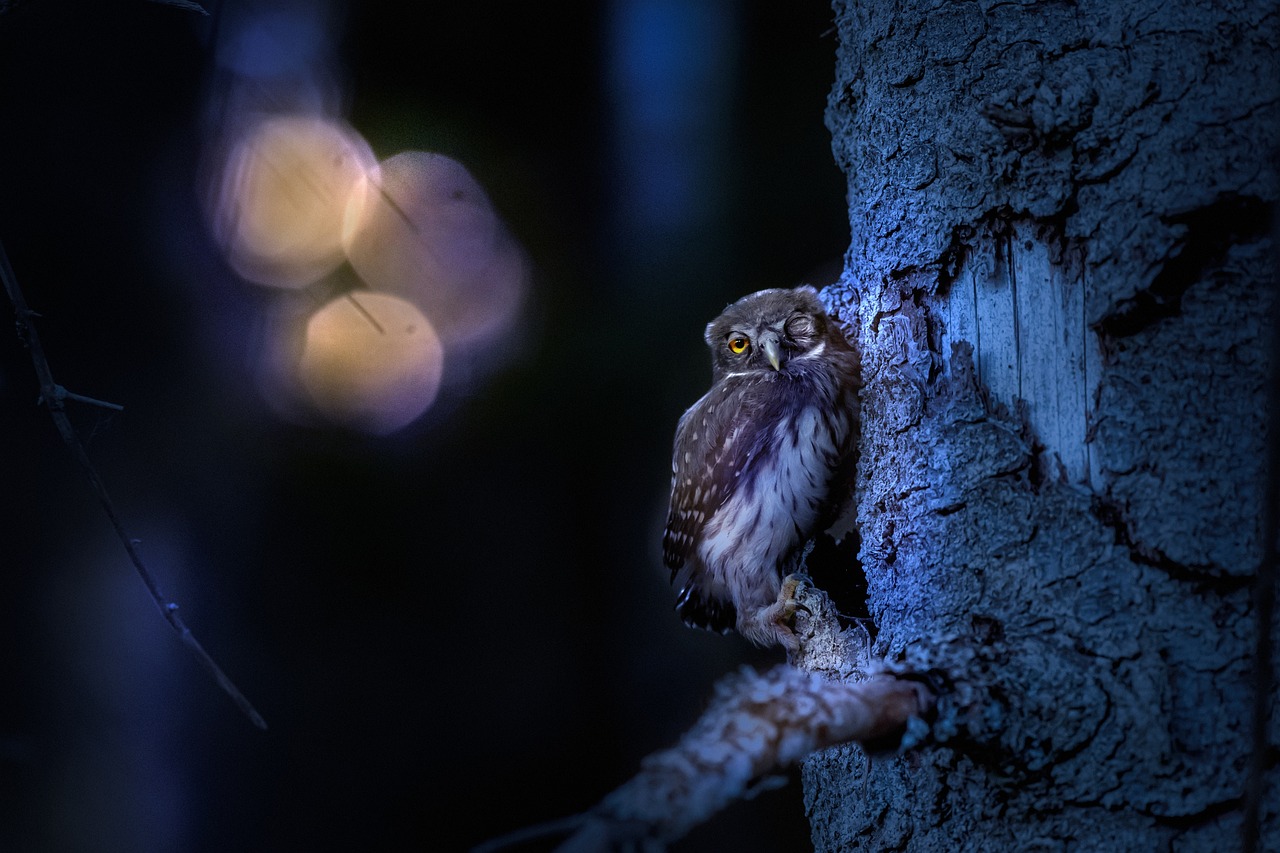Here’s a full, detailed overview of the Eurasian Pygmy Owl (Glaucidium passerinum), Europe’s smallest owl and one of its most fascinating forest predators.
🦉 Eurasian Pygmy Owl (Glaucidium passerinum)
Taxonomy
- Kingdom: Animalia
- Phylum: Chordata
- Class: Aves
- Order: Strigiformes
- Family: Strigidae
- Genus: Glaucidium
- Species: G. passerinum
Common names: Eurasian Pygmy Owl, Northern Pygmy Owl (in parts of Asia)
Scientific name: Glaucidium passerinum
General Description
The Eurasian Pygmy Owl is a tiny but fierce predator — the smallest owl in Europe, yet one of the most active hunters. Despite its miniature size, it preys on animals almost as large as itself.
- Length: 15–19 cm
- Wingspan: 32–39 cm
- Weight: 50–80 g
- Plumage:
- Upperparts: brown or grayish-brown with small white spots.
- Underparts: white with fine brown streaks.
- Tail: short, with several pale bands.
- Eyes: bright yellow, with an intense forward gaze.
- Nape: false “eye spots” — dark patches that mimic eyes to deter attackers.
Both sexes look alike, though females are slightly larger.
Distribution and Range
The Eurasian Pygmy Owl has a wide Palearctic range, occurring across northern and central Europe into Siberia.
Range includes:
- Scandinavia and the Baltic States
- Central and Eastern Europe (Alps, Carpathians)
- Parts of Russia and Siberia
- Northern Italy, Germany, Poland, Estonia, Finland
- Local populations in the Balkans and Turkey
It is mainly a resident bird, though individuals may move to lower elevations or southward during harsh winters.
Habitat
Prefers coniferous and mixed forests, especially:
- Old spruce, pine, and fir forests
- Forests with clearings or edges
- Mountainous and boreal regions
- Areas with plenty of nesting cavities (often made by woodpeckers)
Elevation range: from lowland forests up to 2,000 m in mountains.
Behavior
The Eurasian Pygmy Owl is diurnal and crepuscular, meaning it hunts mostly at dawn and dusk, but also during daylight. This sets it apart from most other owls.
- Hunting style: Active, fast, and precise. It perches silently, then swoops quickly on prey.
- Vocalization: A clear, high-pitched whistling “puu-puu-puu” repeated at regular intervals — most often heard in early morning or evening in spring and autumn.
- Territorial: Males defend small territories and use calls to attract mates and deter rivals.
- Storage behavior: Often stores excess prey in tree holes or crevices during autumn for later consumption.
Diet
Despite its size, the pygmy owl is a skilled hunter.
Main diet:
- Small birds (tits, finches, warblers, sparrows)
- Small mammals (voles, shrews, mice)
- Occasionally insects, frogs, and lizards
It can carry prey up to its own weight and caches food for winter.
Breeding
- Breeding season: April–June
- Nest site: Old woodpecker holes (especially from the Great Spotted Woodpecker)
- Clutch size: 3–7 white eggs
- Incubation: ~28 days, mostly by the female
- Fledging: Young leave the nest after 30–35 days
The male provides food for both the female and chicks during incubation. After fledging, young owlets remain dependent for several weeks.
Identification Summary
| Feature | Description |
|---|---|
| Scientific Name | Glaucidium passerinum |
| Common Name | Eurasian Pygmy Owl |
| Length | 15–19 cm |
| Wingspan | 32–39 cm |
| Weight | 50–80 g |
| Plumage | Brown with white spots; streaked underparts |
| Eyes | Yellow |
| Habitat | Boreal & mixed coniferous forests |
| Activity | Daytime & dusk hunter |
| Diet | Small birds and mammals |
| Nesting | Tree cavities, often old woodpecker holes |
| Conservation Status | Least Concern |
Predators and Threats
- Larger owls (especially Tengmalm’s and Ural Owls)
- Hawks and martens
- Habitat loss through forestry, removal of old trees, and loss of woodpecker holes
Conservation Status
- IUCN Red List: 🟩 Least Concern
- Population trend: Stable overall, though declining locally due to habitat loss.
Conservation measures:
- Protect mature coniferous forests and deadwood trees.
- Install nest boxes in managed forests.
- Maintain woodpecker populations that create nesting holes.
Interesting Facts
- The smallest owl in Europe — yet one of the boldest.
- Hunts during the day, unlike most owls.
- Creates food caches in autumn, storing up to 50 small prey items.
- Its false eyespots on the back of the head may deter predators or confuse prey.
- Despite being tiny, its call carries far through forests — up to 1 km.
Ecological Role
The Eurasian Pygmy Owl plays an important role as a predator of small mammals and birds, helping control populations of rodents and maintaining ecological balance in forest ecosystems.
Summary
The Eurasian Pygmy Owl (Glaucidium passerinum) is a miniature but mighty predator of northern and central Europe’s forests. Active by day and dusk, it is famous for its whistled call, fierce hunting skills, and endearing size. Living mainly in coniferous woods, it nests in old woodpecker holes and can even cache prey for winter. Though small, it is a vital part of boreal forest ecosystems — a true symbol of wild, undisturbed woodland habitats.
Views: 1482
Subscribe to the newsletter:
